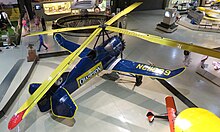|
Pitcairn PCA-2
The Pitcairn PCA-2 was an autogyro (designated as "autogiro" by Pitcairn) developed in the United States in the early 1930s.[1] It was Harold F. Pitcairn's first autogyro design to be sold in quantity. It had a conventional design for its day – an airplane-like fuselage with two open cockpits in tandem, and an engine mounted tractor-fashion in the nose.[2] The lift by the four-blade main rotor was augmented by stubby, low-set monoplane wings that also carried the control surfaces.[2] The wingtips featured considerable dihedral that acted as winglets for added stability.[2] Operational historyThe PCA-2 was the first rotary-wing aircraft to achieve type certification in the United States[3] and was used in a number of high-profile activities including a landing on the White House lawn[4][5] and the first flight across the United States in a rotorcraft. This latter feat was attempted by Amelia Earhart, flying for the Beech-Nut food company, but was actually accomplished by John M Miller who completed his flight nine days before Earhart on 28 May 1931, in his PCA-2 named Missing Link.[6] Learning of Miller's achievement upon her arrival in California, Earhart set out to turn her flight into a round-trip record by flying east again, but abandoned the attempt after three crashes.[6] Earhart set an altitude record in a PCA-2 on 8 April 1931 with a height of 18,415 ft (5,615 m). [7][2][3][4] This record was broken in another PCA-2 by Lewis Yancey who flew to 21,500 ft (6,600 m) on 25 September 1932.[3][8]  In 1931, The Detroit News made history when it bought a PCA-2 for use as a news aircraft due to its ability to fly well at low altitude, land and take off from restricted spaces, and semi-hover for better camera shots. In May 1933, Scripps donated the autogyro to the Henry Ford Museum in Dearborn, Michigan.[9]   The Champion spark plug company operated a PCA-2 as a promotional machine in 1931 and 1932 as Miss Champion.[4] It was flown over 6,500 miles in the 1931 Ford National Reliability Air Tour. This machine was restored to flying condition in 1982 by Steve Pitcairn, Harold's son.[4] In 2005, he donated it to the EAA AirVenture Museum.[4] Other PCA-2s are preserved at The Henry Ford[4][10] and the Canada Aviation Museum.[11] Variants
Operators (OP-1)Specifications (PCA-2)General characteristics
Performance
See alsoRelated development Aircraft of comparable role, configuration, and era
ReferencesNotes
Bibliography
External linksWikimedia Commons has media related to Pitcairn PCA-2. |
||||||||||||||||||||
